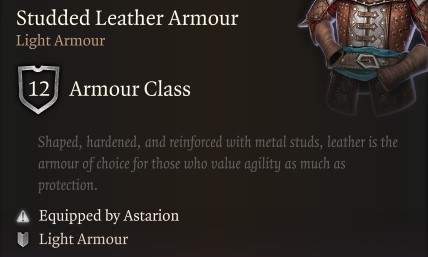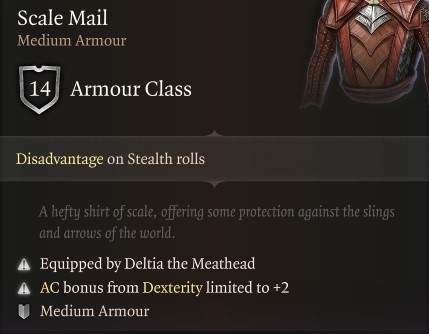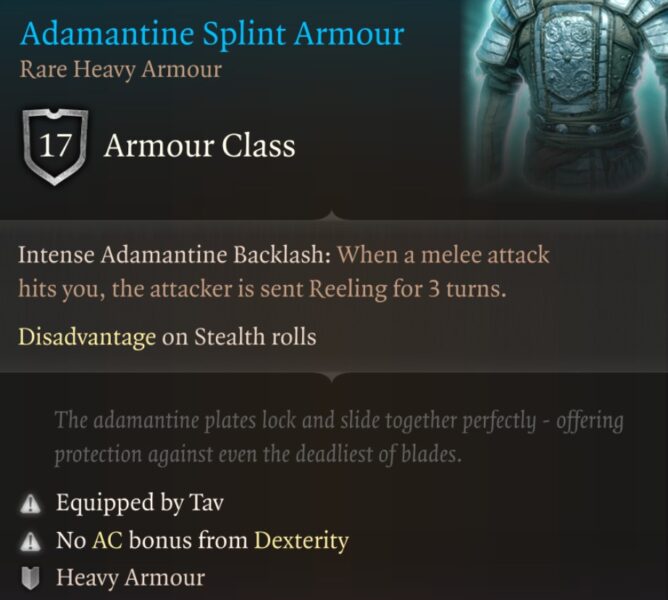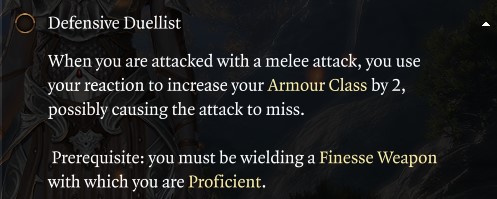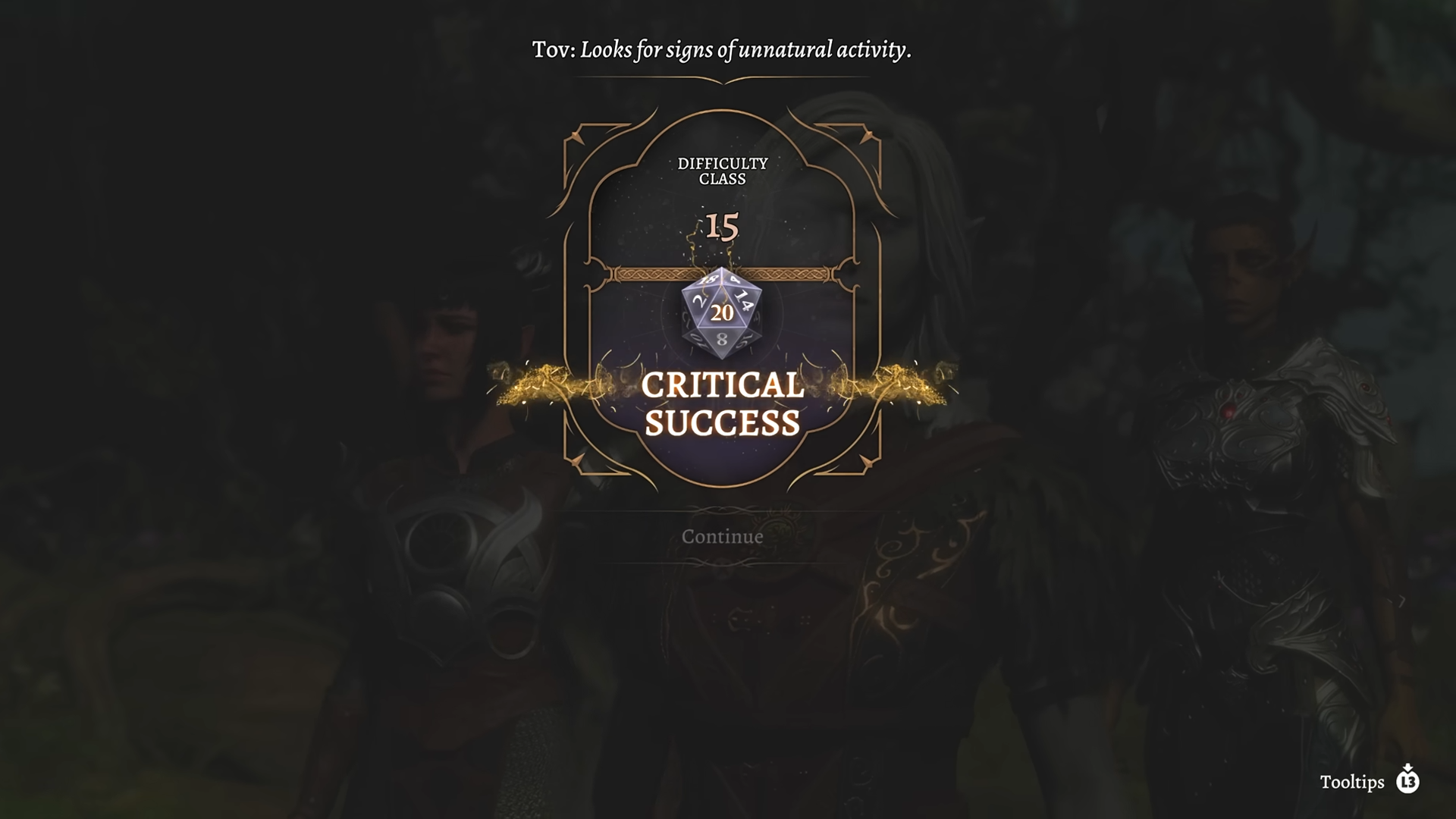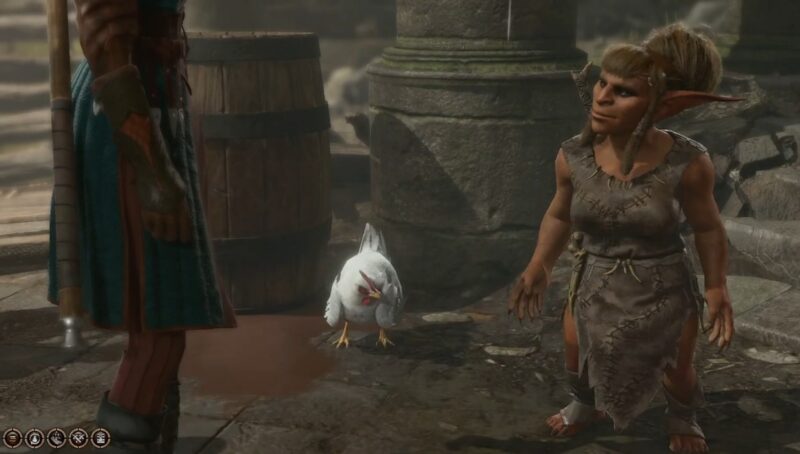In this guide, we delve into the intricacies of equipping your character with the finest BG3 armour and understanding Armour Class (AC) and Armour Proficiency in Baldur’s Gate 3.

Armour Types in Baldur’s Gate 3
There are three types of Armour in Baldur’s Gate 3, Light, Medium, and Heavy. Using armour provides Armour Class (AC), which is a measure of how difficult it is for an enemy to hit you with an attack. A higher AC means that you are more difficult to hit, while a lower AC means that you are easier to hit. Unlike other games with an armour mechanic that mitigates or lowers damage, Baldur’s Gate 3 is all about avoidance. Shields can also increase AC by +2 regardless of your armour. Here are some examples of armour in Baldur’s Gate 3:
- Light Armour: characters with a Dexterity-focused build benefit most from light armour because it allows for a Dexterity modifier to be added to AC.
- Medium Armour: Medium armour offers better protection than light armour, but you only get a small bonus of AC with a Dexterity modifier.
- Heavy Armour: Heavy provides the most protection and is best for strength and constitution-based builds.
- Shields: shields are essential accessories that can be used in conjunction with armour to increase a character’s Armour Class (AC).
A character’s proficiency with a specific armour type determines whether they can wear and effectively use that type of armour. Certain classes, races, or backgrounds grant proficiency in specific armour types, allowing characters to choose the armour that best complements their abilities and playstyle.
Read more:
Armour Proficiency
In Baldur’s Gate 3, armour proficiency is a system that determines a character’s ability to effectively use and wear different types of armour. Proficiency in armour grants various benefits, while lacking proficiency may lead to penalties or restrictions like being unable to cast spells or receiving a disadvantage on rolls.
Here’s a chart showing the armour proficiencies of each class in Baldur’s Gate 3 (BG3):
| Class | Light Armour | Medium Armour | Heavy Armour | Shield |
| Barbarian | Yes | Yes | No | Yes |
| Bard | Yes | No | No | No |
| Cleric | Yes | Yes | No | Yes |
| Druid | Yes | Yes | No | Yes |
| Fighter | Yes | Yes | Yes | Yes |
| Paladin | Yes | Yes | Yes | Yes |
| Ranger | Yes | Yes | No | Yes |
| Rogue | Yes | No | No | No |
| Sorcerer | No | No | No | No |
| Warlock | Yes | No | No | No |
| Wizard | No | No | No | No |
The table above isn’t an exhaustive list because feats, subclasses, and other factors can add to armour proficiency. Heavily Armoured is a feat that gains proficiency with Heavy Armour and increases your Strength score by 1, to a maximum of 20. At level four, each class can pick either ability score increases or a feat. Most do not select armour proficiency-based feats, because ability increase is so strong. But you need to know, it’s possible to gain different armour proficiency types, even if your base class doesn’t have it.
Another example of this is the Cleric class. By default, they only have access to light, medium, and shield proficiency. At level one, you can pick a subclass as a Cleric. The Life subclass, considered support, offers heavy armour proficiency. The simplest way to find out is by opening your character sheet and scrolling over proficiency. You can also select the character, then the item you want to equip. The game will tell you if you do not have proficiency. Equip heavy armour on a Wizard and you won’t be able to cast spells, so this becomes quick.
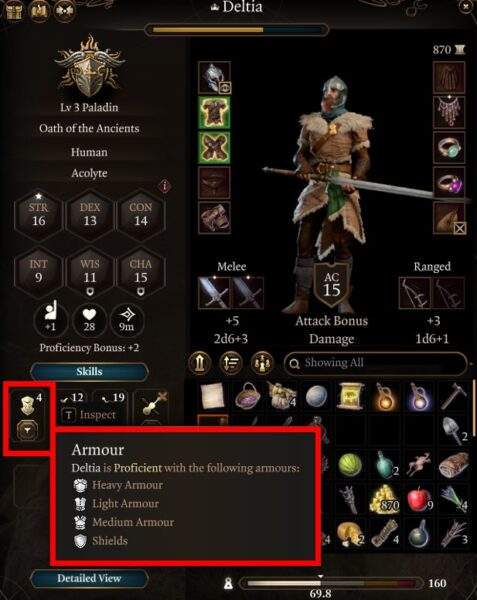
Read more:
How to Determine Your Armour Class (AC) in Baldur’s Gate 3
If your character is not equipped with any armour or shield, their Armour Class (AC) is calculated as a base of 10 plus their Dexterity modifier. This means the enemy must roll a 10 or higher to hit you. By default dice rolls, which are handled in the background combat log, are 20-sided dice. Having a higher AC improves your chances of avoiding getting hit.
Here’s how the armour in Baldur’s Gate 3 calculates Armour Class (AC):
- Light Armour: Dexterity modifier added to based equipped armour.
- Medium Armour: Gain +2 max Dexterity modifier plus equipped armour.
- Heavy Armour: No benefit from Dexterity modifier.
- Shields: increase your AC +2 regardless of armour.
An example would be Astarion wearing a Studded Leather Armour (light) with 12 Armour Class. He has 17 Dexterity which rewards him with a +3 Dexterity Modifier. Adding this together, he gets 15 AC from this light armour chest piece.
A medium armour user, even with 16 or higher Dexterity would only get a +2 to their AC score. This is why Light Armour is ideal for rogues, rangers, and any class with a +3 or higher Dexterity modifier.
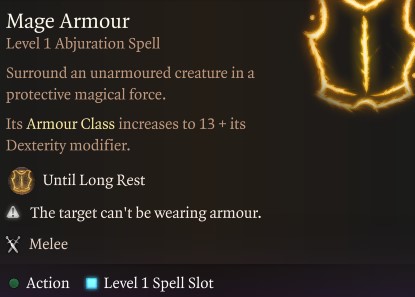
Wizards, on the other hand, have no proficiency in armour by default and wear clothing. Their solution to deal with low AC is spells. Mages Armour increases base AC to 13 + Dexterity modifier. If your Wizard has 14 or higher Dexterity, plus Mages Armour active, they have a 15 AC score. Mage Armour is essential for this class and stays on your character until a long rest. Make sure to cast it after a long rest to keep survival high.
Also Check:- BG3 Interactive Map
Tips for Increasing Your Armour Class in BG3
Here are ten tips for increasing Armour Class (AC) in Baldur’s Gate 3:
- Equip Shield: equipping a shield will give you a +2 in addition to other armour.
- Invest in Dexterity: characters in light or medium armour with high DEX scores gain a bonus to their AC.
- Defensive Duelist Feat: When you are attacked with a melee attack, you use your reaction to increase your Armour Class.
- Armour Feats: look to take additional armor feats at level 4 like medium or heavy armour proficiency in BG3.
- Potions of Speed: this potion gives +2 AC along with additional action for three turns.
- Mages Armour: cast this on a Wizard to increase AC to 13 + Dexterity modifier.
- Mirror Image: creates three duplicates of you, each increases your AC by 3!
- Scrolls: if you don’t have spells by default, use scrolls for Mirror Image to help boost AC.
- Better armour: check your inventory, traders, and companions’ armour and swap out for higher AC as you progress.
- Trader Wares: if you cannot find better armour at traders, use the long rest function and refresh their inventory.
Remember that having a high AC is essential for your survival, but it’s also crucial to balance it with other aspects of your character’s build. Experiment with different combinations of armour, attributes, and abilities to find the playstyle that best suits your character and the challenges you’ll face in Baldur’s Gate 3.
Looking For More About Baldur’s Gate 3?
Thank you for reading Baldur’s Gate 3 Armour & Armour Class Guide Guide. We provide the latest news and create guides for Baldur’s Gate 3. Also, watch me play games on Twitch or visit my YouTube channel!
 Reddit
Reddit
 Email
Email
